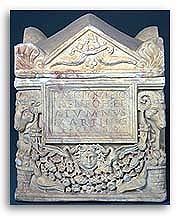
|
|
Urn This marble container was used to hold the bones and ashes of a deceased person in ancient Rome. Called "cineraria," the urns were usually placed in underground chambers with niches in the walls for the individual urns. These chambers might belong to an extended family or to a burial society, which charged people a fee to bury them and maintain their burial. This cinerary urn from the Carlos Museum is unfinished on the back suggesting that it was placed in a niche. |
| Roman cinerary urns were mass-produced and personalized with an inscription. The inscription on this urn reads: |
| The decorations carved on the front of the urn relate to its funerary function. The Medusa head in the center served to guard the urn and to ward off anyone who would disturb it. Do you see the garland of flowers and fruit that hangs from the Ram's horns and goes under Medusa? It is probably meant to represent the garlands that were part of the funeral procession. |
 |
 |
 |
 |
 |
 |
 |
© Michael C. Carlos Museum of Emory University,
Memorial Art Gallery of the University of Rochester and Dallas Museum of Art
For more information please contact odyssey@emory.edu.
Last Update:
